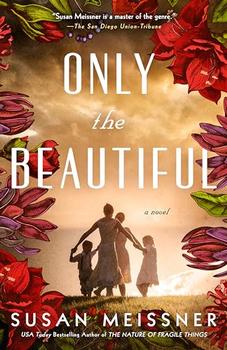Summary | Excerpt | Reading Guide | Discuss | Reviews | Beyond the Book | Read-Alikes | Genres & Themes | Author Bio

This article relates to Only the Beautiful
In Only the Beautiful, the historical novel by Susan Meissner, readers are introduced to Rosanne "Rosie" Maras, a teenage girl who has lost her family and is placed under the care of her parents' former employers. To most, Rosie seems like a normal girl, but she's hiding a secret: when she hears sounds, she sees colors. When her secret is revealed—amidst other shocking discoveries—Rosie is sent to a state home where doctors try to "cure" her of what they deem a disability.
Today, Rosie's ability is known as synesthesia, defined as "a neurological condition in which stimulation of one sensory or cognitive pathway…leads to automatic, involuntary experiences in a second sensory or cognitive pathway." In other words, when people with synesthesia experience a sensation via one sense it also activates another sense, such as a sound invoking an image of a certain color. Synesthesia was first documented in 1812 by German physician George Tobias Ludwig Sachs, who reported on his own experience with the phenomenon of seeing colors when hearing music. This form of synesthesia, which Rosie also experiences, is known as chromesthesia and is common among musicians. Other forms include seeing a color when viewing a number or a letter (grapheme-color synesthesia), sensing being touched when seeing someone else touched (mirror-touch synesthesia), or experiencing a specific taste when hearing a particular word (lexical-gustatory synesthesia). Scientists believe there may be up to 80 subtypes of synesthesia combining different senses in unique ways.
In the past, synesthetes were typically seen as overly imaginative at best and as disturbed individuals who ought to be placed in mental institutions at worst. It has only been since the latter half of the 20th century that synesthesia has been regarded as a real neurological condition worthy of research. There are still many unanswered questions regarding the causes of synesthesia, but research within the last two decades has shown that during prenatal development and early infancy, the senses do not function independently, meaning everyone begins life as a synesthete. By eight months of age, however, most infants have developed distinct neural pathways for each sense and thus experience them separately. It is consequently hypothesized that adult synesthesia is the result of cases where this abundance of sensory pathways in the brain is not dismantled.
Synesthesia is estimated to occur in 3-5% of the population, although lack of standardization in tests used to diagnose synesthesia (meaning a person may have the condition according to one test, but not according to another) and the fact that most cases of synesthesia are self-reported make determining its prevalence difficult. There is known to be a genetic component to synesthesia—cases tend to cluster in families—and a few dozen genes have been identified as likely predictors as to whether an individual will inherit synesthesia. While most synesthetes are born with blended senses, the condition can occur later in life, either permanently or, more commonly, temporarily. Health conditions such as head trauma, stroke, or brain tumors can affect the neural connections in the brain and cause synesthesia in individuals who did not previously have it. The use of hallucinogenic drugs can also induce synesthesia for a brief period, although which senses are stimulated while under their influence is not consistent, and therefore, this is not considered a genuine synesthetic experience. Interestingly, some people have attempted to temporarily simulate synesthesia using less mind-altering methods: the British performance troop BitterSuite was inspired by synesthesia and immersive experiences to create a program that combines the senses in unique ways. Audience members are blindfolded before being exposed to music, smells, and foods in an attempt to mimic the world as experienced by synesthetes.
Performances such as those by BitterSuite as well as increased scientific interest in synesthesia show just how differently the condition is understood in modern times compared with the days when individuals were seen as disturbed for claiming to "see" music. Although much remains unknown about synesthesia, researchers have learned a great deal about its origins and have helped alter the negative perceptions of the condition. Unlike Rosie's experiences in Only the Beautiful, today synesthesia is not considered a disorder and synesthetes often find their lives enhanced by the multisensory experience conferred by their unique and colorful condition.
See also Chromesthesia
Filed under Medicine, Science and Tech
![]() This "beyond the book article" relates to Only the Beautiful. It originally ran in May 2023 and has been updated for the
March 2024 paperback edition.
Go to magazine.
This "beyond the book article" relates to Only the Beautiful. It originally ran in May 2023 and has been updated for the
March 2024 paperback edition.
Go to magazine.
Your guide toexceptional books
BookBrowse seeks out and recommends the best in contemporary fiction and nonfiction—books that not only engage and entertain but also deepen our understanding of ourselves and the world around us.